Have you noticed when you stand in front of the class to begin teaching your students slouch down in their seats in a lackluster or defensive manner, assuming that another whole group lesson will be boring or too difficult? The design of the classroom space lets students know if it is teacher centered or student centered. Students can tell by the desk arrangement and the positioning of resources if there will be collaborative work, independent work, small group focus lessons or large group discussions.
If you want students to collaborate, give them an environment that encourages it. The individual elements of a classroom space work together to create an atmosphere that can either inspire students or stifle them. With that in mind, it’s easy to see what sort of negative effects a traditional classroom may have with its rigid design and structure. Active learning and true engagement require a far more flexible environment, one that gives students room to explore and succeed.
A learning environment that is conducive to students needs can help them develop both new knowledge and skills as well as performance, moral and civic character by experiencing the feelings of competence, belonging, security, friendliness, citizenship, cooperation, curiosity, creativity, and responsibility. We believe, as stated in the Academic Excellence Framework, that when teachers ENGAGE in intentionally planning a functional learning environment, they seek to improve learning as efficiently, effectively, and equitably as possible for ALL students, including those with differing abilities.
Here are five ways to make your classroom learning environment the third teacher; equal in importance as a parent or teacher. Make these distinct learning environments: focused learning environment, collaborative learning environment, and hands-on project-based learning environment.
- Design a flexible learning environment. Populate classrooms or “learning studios” with movable furniture and walls that can be reconfigured for different learning situations. Make your classroom space flexible, changing the seating arrangement based on whether students are working collaboratively, individually or having a group discussion or mini-lesson with the teacher. Outline your floor plan, room space to design a more functional space.
- Facilitate spontaneous collaboration. Convert walls into corner studios with whiteboard writable walls as a student working space. Position easels, tables, filing cabinets, and bookcases to create spaces and places for note taking, brainstorming, researching and experimenting. Move beyond using your interactive whiteboard as a glorified projector screen to using it as an active part of your students’ daily educational experience.
3. Create 21st Century 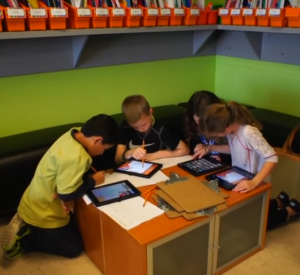 Classroom Opportunities. Intentionally organize laptops, tablets and other technology resources for individual and group work. Give students choices for research, practice, and presentations in a technology space. Integrated into the curriculum, technology tools to powerfully extend learning. In today’s interconnected and technology-drive world, these tools can provide students and teachers with:
Classroom Opportunities. Intentionally organize laptops, tablets and other technology resources for individual and group work. Give students choices for research, practice, and presentations in a technology space. Integrated into the curriculum, technology tools to powerfully extend learning. In today’s interconnected and technology-drive world, these tools can provide students and teachers with:
- Access to up-to-date, primary source material,
- Methods of collecting/recording data,
- Ways to collaborate with others around the world,
- Opportunities for expressing understanding
- Plan the environment based on your students’ needs. Foster learning tailored to the needs and wants of each student. Such environments offer the opportunity for students to “acquire and own” knowledge and skills in a personalized space, adapted to the student’s own learning styles and preferences. Provide comfortable seating and lighting for students who need an alternative to the typical classroom chairs and desks.
- Drum up donations to support your classroom makeover. Start a fund raising campaign at Indiegogo and Donors Choose. Write grants through NOVA for school furniture. Plan a drive-by at the local college during graduation week to collect furniture to recycle. Contact other organizations for reusable equipment, like The Reuse Network. Re-purpose materials you already have for 21st century functionality. Take a tour of classrooms at your school and use a T-chart to take notes on what you notice that makes the classroom space Teacher-Center or Student-Centered.
Think of an optimal learning environment as the support system that organizes the condition in which humans learn best. Each classroom space becomes a learning platform for authentic connections which ignites students’ thinking and learning. Greater interaction and communication between students and enhanced engagement, exploration and purposeful application of learning will take place. The learning spaces empower learners; teachers are facilitators, students are on the move. This type of learning environment provides the structures, tools, and communities that inspire students and educators to attain the knowledge and skills the 21st century demands of us all.
Other Resources
8 Tips and Tricks to Redesign your Classroom
Remake Your Class Part 1: Planning for a Collaborative Learning Environment
Remake Your Class Part 2: Building a Collaborative Learning Environment
Remake Your Class Part 3: Exploring a Collaborative Learning Environment
Mind/Shift “For Back to School, Reimagine School Design”
21st Century Learning Environment
New Learning Environments for the 21st Century
Transforming Classroom and Schools for 21st Century Learners by Design

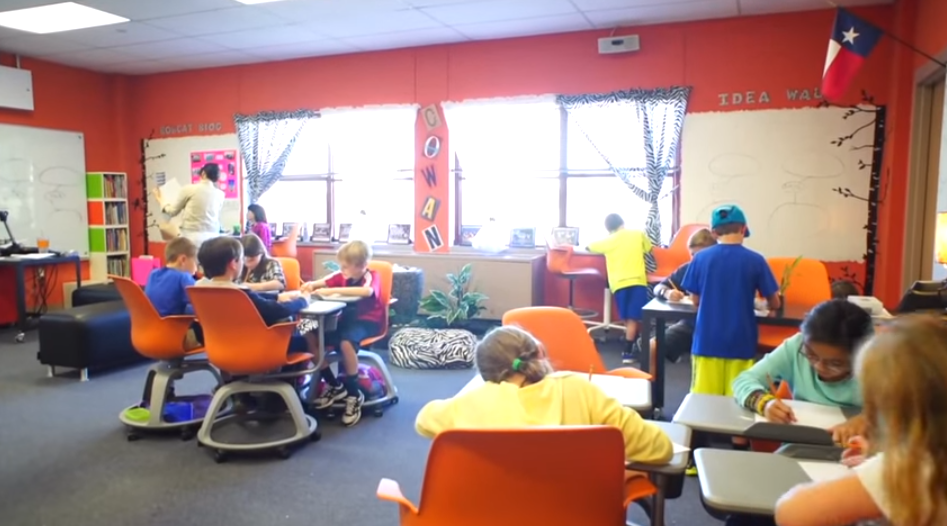
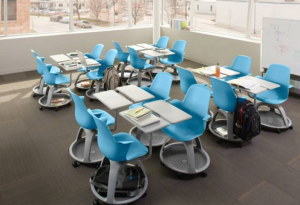
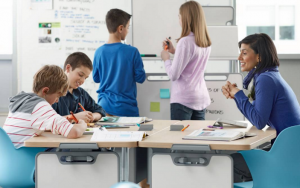
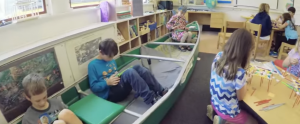
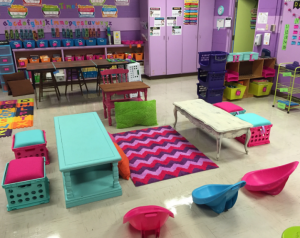
Comments 10
Thanks for sharing these resources, I love #2 Facilitate Spontaneous Conversations. Walking into a room, I can tell by the arrangement if students have opportunities to collaborate or if they are isolated to work individually. To take it to the next level, I love the idea of creating walls that are interactive – chalkboard paint is a useful way to create spaces for students to write, but also simply using sticky notes! The more opportunities we provide students to collaborate the deeper the understanding, this means it is up to us to provide that opportunity and making the environment conducive is the first step!
I happen to be in a particularly small and challenging space, but we make the best of it. Sometime in January I had one of those “ho hum” weeks and decided to shake things up. I made a commitment to my class that every Friday morning, we would push all the furniture to the side, sit on the floor as a class, and read a book they select from some of my multicultural literature selections. We discuss the story as it unfolds however I promised there would be NO tests and no written assignments beyond the discussion. I have to say, it is my favorite part of the week and the part that the kids look forward to as well. I also find that my own feelings towards the class are always warmer after our reading session, compared to wrestling them through whatever standard we are working on.
A big part of this is changing the dialogue from teacher/student to co-learner/co-learner a la Paolo Freire’s banking system of education. The seating makes an immediate impact, whether on children or on adults. I will admit though, even I struggle to stay away from rows as testing nears and those “worrisome” students need to be wrestled into focus and convinced to perform. Dump testing and I’d have the most welcoming, exploratory classroom around.
I am so excited that Carole Sites shared this blog with me. I am constantly struggling with how to best arrange my room for my 8th grade science and robotics classes. I think #1 fits my philosophy perfectly, my students laugh at how often i change my classroom around (sometimes I have different arrangements for different classes throughout the day). Thank you for posting resources for grants, I am hoping to get better/more comfortable furniture in the classroom for the student to enjoy. Lastly, I like #2 and was thinking of mini whiteboards hanging for students to use then I thought about the whiteboard paint and that could be a possibility. It would come in really handy in my robotics when they have to rapid design ideas for their robots.
Thanks again!
At Imagine Bella, all teachers took the time to create a classroom environment that is stimulating, comfortable, and flexible for student learning. Even with only being required to have one area of flexible seating our teachers took it above and beyond, including multiple areas for students to perform optimally while in comfort. Students are given the option to find areas that work best for them and where they will be most comfortable. As well, we continue to incorporate technology and meaningful ways for students to engage in content; SmartBoards, white board tables, easels, chrome books, desktops, iPads, etc. We are continuously growing and forming an environment that provides students with the most opportunities for success. To improve, we could take suggestions from #5 and create start-up accounts to ease the financial responsibility.
Flexible seating is a great idea. Over the winter break, I changed my classroom to flexible seating. I love the idea, but feel that it is something that needs to be started and reinforced from the beginning of the year. Next year, I want to add more group work and working collaboratively to use the flexible learning spaces more effectively.
I love the idea of writable whiteboard walls and using the interactive whiteboard as a center. We have been trying out flexible seating and I would like to do more with it next year so the ideas for fundraising and grants are great as well.
This article emphasizes what I have been trying to do in my classroom more and more throughout the year. I started out with a pretty standard classroom with a few flexible seating options. As the year has gone on, I have rearranged multiple times and opened up more spaces for working. I try to always include opportunities for partners and collaborations. I’m hoping to take what I have learned this year to take it to the next level next year.
I had a canoe in my classroom in 1989! The students all loved it. Little did I know that years(decades) later using such non-traditional items as furniture would become the wave of the future! I experimented a bit this year with lowered tables, paint buckets and logs. I even had a hammock that became a favorite cozy reading spot.
I loved the idea of contacting colleges as school years end to accumulate tossed furniture. I have spotted so many things I could have used!
Linda, I understand your challenge with arranging for an optimal learning environment in a small space. When I visited Imagine Plantation a couple of weeks ago, I was impressed with the flexible use of space created by several teachers in their small classrooms. You may want to take a trip over to the campus, and see what they have accomplished. There’s some creative ideas.
Thank you all for your comments. I can see that this is an important topic and I hope one discussed with your School Development and Economic Sustainability Measure of Excellence Committee as you determine purchases for next year. I hope to see some flexible learning spaces when visiting classrooms next school year.